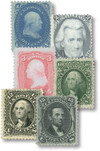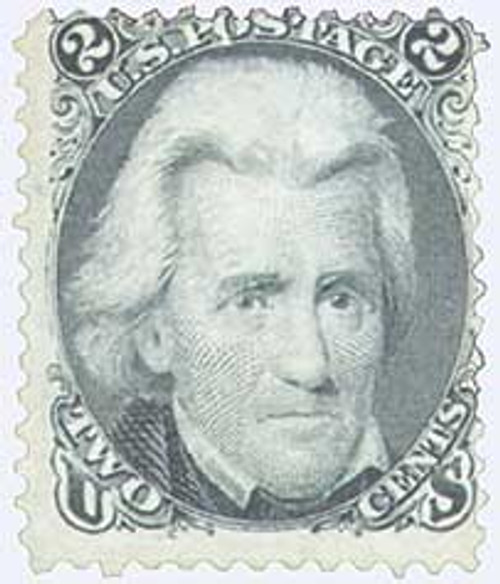
# 86-91 - Complete Set, 1867 Series of "E" Grill
Own the Complete Series of 1867 “E” Grills
These stamps were produced as part of a Post Office Experiment to deter the reuse of stamps. At the time, the government believed people were removing cancellations from stamps and reusing them. Inventors of that time turned their talents to creating a device that would make the cleaning of stamps impossible. This experimentation led to the creation of grills.
Grills were made by embossing the stamp, breaking paper fibers, and allowing canceling ink to soak deeply into the paper. This made it difficult to remove cancels and reuse stamps. Charles Steel, who oversaw postage stamp production in the 1860s, patented the grilling method. It was used nine short years – 1867 to 1875. With this special offer, you can own all six stamps produced with the “E” Grill. You can discover more about grills below.
Series of 1867
Grills are classified by the dimensions of the grill pattern and are measured in millimeters or by counting the number of grill points. There are eleven major classifications.
“A” Grill Covers the entire stamp
“B” Grill 18x15mm (22x18pts)
“C” Grill 13x16mm (16-17x18-21pts)
“D” Grill 12x14mm (15-17-18pts)
“Z” Grill 11x14mm (13-14x18pts)
“E” Grill 11x13mm (14x15-17pts)
“F” Grill 9x13mm (11-12x15-17pts)
“G” Grill 9 ½ x9mm (12x11-11 ½ pts)
“H” Grill 10x12mm (11-13x14-16pts)
“I” Grill 8 ½ x10mm (10x11x10-13pts)
“J” Grill 7x9 ½ mm (10x12pts)
The letters that classify the various grill types do not denote the size, shape, or appearance of the grills. Rather, they simply indicate the order in which they were discovered.
The exception to the rule is the “Z” grill, which was identified by William L. Stevenson. Stevenson could not decide to which family of grills this particular type belonged. Nor did he know which other families it preceded or followed and so he designated it as “Z Grill,” where “Z” signifies the unknown.
Visible in general from the back of the stamp only, grills may also be felt by lightly running a fingertip over the surface. Depending on which type of roller was used, the pattern may be “points up” or a “points down.” The ridges on an indented roller force the paper into the recesses, creating raised points, while a roller with raised pyramids will cause the points to be forced down into the paper, forming a series of depressions.
The United States was the first country to issue grilled stamps and was the only country to do so until the mid-1870s, when Peru also began using grills. The National Bank Note Company was responsible for producing both countries’ stamps.
Own the Complete Series of 1867 “E” Grills
These stamps were produced as part of a Post Office Experiment to deter the reuse of stamps. At the time, the government believed people were removing cancellations from stamps and reusing them. Inventors of that time turned their talents to creating a device that would make the cleaning of stamps impossible. This experimentation led to the creation of grills.
Grills were made by embossing the stamp, breaking paper fibers, and allowing canceling ink to soak deeply into the paper. This made it difficult to remove cancels and reuse stamps. Charles Steel, who oversaw postage stamp production in the 1860s, patented the grilling method. It was used nine short years – 1867 to 1875. With this special offer, you can own all six stamps produced with the “E” Grill. You can discover more about grills below.
Series of 1867
Grills are classified by the dimensions of the grill pattern and are measured in millimeters or by counting the number of grill points. There are eleven major classifications.
“A” Grill Covers the entire stamp
“B” Grill 18x15mm (22x18pts)
“C” Grill 13x16mm (16-17x18-21pts)
“D” Grill 12x14mm (15-17-18pts)
“Z” Grill 11x14mm (13-14x18pts)
“E” Grill 11x13mm (14x15-17pts)
“F” Grill 9x13mm (11-12x15-17pts)
“G” Grill 9 ½ x9mm (12x11-11 ½ pts)
“H” Grill 10x12mm (11-13x14-16pts)
“I” Grill 8 ½ x10mm (10x11x10-13pts)
“J” Grill 7x9 ½ mm (10x12pts)
The letters that classify the various grill types do not denote the size, shape, or appearance of the grills. Rather, they simply indicate the order in which they were discovered.
The exception to the rule is the “Z” grill, which was identified by William L. Stevenson. Stevenson could not decide to which family of grills this particular type belonged. Nor did he know which other families it preceded or followed and so he designated it as “Z Grill,” where “Z” signifies the unknown.
Visible in general from the back of the stamp only, grills may also be felt by lightly running a fingertip over the surface. Depending on which type of roller was used, the pattern may be “points up” or a “points down.” The ridges on an indented roller force the paper into the recesses, creating raised points, while a roller with raised pyramids will cause the points to be forced down into the paper, forming a series of depressions.
The United States was the first country to issue grilled stamps and was the only country to do so until the mid-1870s, when Peru also began using grills. The National Bank Note Company was responsible for producing both countries’ stamps.









